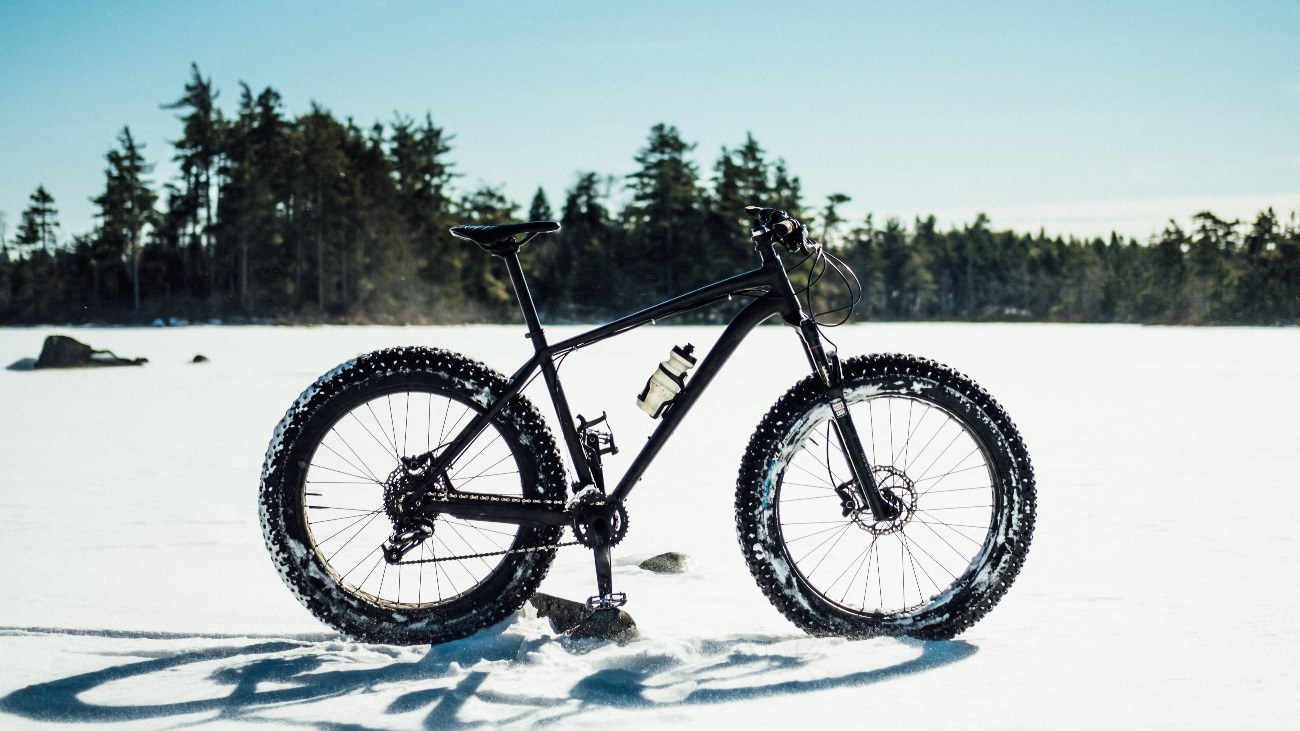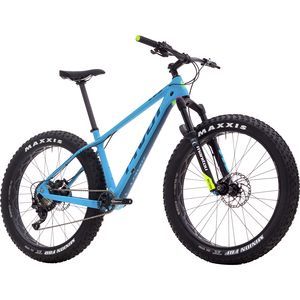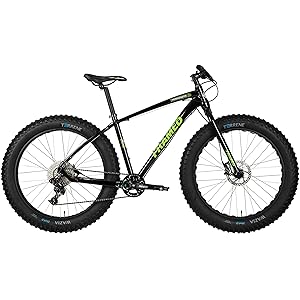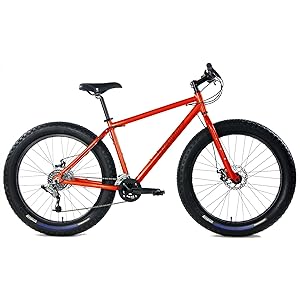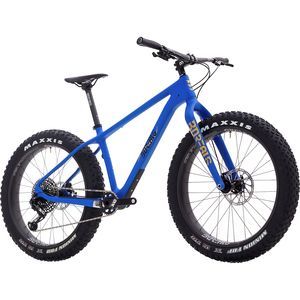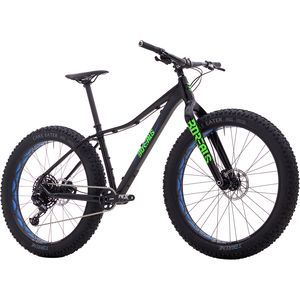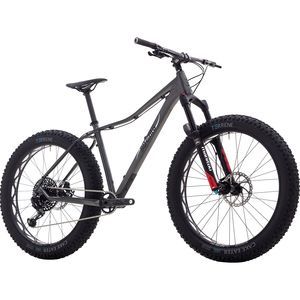Fat bikes are amazingly versatile and super fun to ride. Given there's so much choice, we're on hand to help you find the right one.
Fat tire bikes are great fun. Their ability to ride pretty much anywhere makes their increase in popularity in recent years is no surprise. This increase has a positive effect for consumers, with a massive influx of new fat bikes comes a drop in price.
We want everyone to find their perfect fit, and those looking for their first fat-bike adventure may not be willing to part with $3000+ for a high-end model. We’ve done our best to include the best fat tire bikes for entry, beginner, and intermediate riders.
Best Fat Bikes
If you’re new to fat-biking, it’s advisable to start with something reasonably priced that’ll give you a good feel for the type of ride fat bikes offer. Cheaper fat tire bikes typically have a heavy steel frame, making them hard work to ride for extended periods. As the weight comes down, the price goes up. For fat bikes under 35 pounds in weight you can expect to be shelling out well more than $2000.
Below are the best fat bikes for riders of all skill levels with value for money in mind.
- 1 Pivot LES Fat 27.5 Pro XT/Mastodon Complete Mountain Bike
- 2 Framed Minnesota LTD Fat Bike
- 3 Gravity Monster Aluminum Fat Bike
- 4 Borealis Bikes Crestone X01 Eagle Complete Fat Bike
- 5 Borealis Bikes Flume NX Eagle Complete Fat Bike
- 6 Borealis Bikes Telluride GX Eagle/Mastodon Complete Fat Bike
- 7 Framed Wolftrax Alloy 2.0 w/Shimano Deore (2 x 10) Fat Bike Womens
Pivot LES Fat 27.5 Pro XT/Mastodon Complete Mountain Bike
Pivot’s LES Fat-bike is a carbon fiber framed animal. Pivot’s carbon fiber frames are created with the same hollow-core molding process, resulting in a stiffer, lighter frame that is extremely strong. Pivot are happy to back this strength up with a 10-year warranty on the frame, which clearly displays their confidence in it. The LES is super versatile, allowing for 26 or 27.5-inch fat tires or 27.5 and 29 plus. The price to performance ratio of the components is absolutely excellent, drivetrain and brake components are mostly Shimano XT, with the odd SLX component thrown in elsewhere to keep the price down. When it comes to gears the rear derailleur is a Shimano XT SGS 12-speed. The LES is a hugely impressively bike that would, without a doubt, compete with the very best.
Framed Minnesota LTD Fat Bike
Next up the heavily updated Framed Minnesota LTD fat tire bike. The frame has been given a geometry upgrade and you get a future proof tapered headtube for any potential fork upgrades. The drivetrain has a SRAM NX 1×11 group and you get SRAM level hydraulic breaks for superb stopping power. Axle spacing at 150mm front and rear at 177mm. To top things off this bike comes equipped with ALEX Blizzerk tubeless compatible rims making it a very well rounded bike. The Framed Minnesota has a Hydroformed Aluminium frame with a slightly curved top tube, as well as a fork that looks beautifully balanced, sat on thick 16″ tires – if looks could kill.
Gravity Monster Aluminum Fat Bike
Gravity Monster’s Aluminum Fat-bike is, in our opinion, the best budget fat-bike out there. Even the best budget mountain bikes rarely come this well equipped. With 26 x 4-inch tires and a frame that’s capable of taking tires up to 4.5-inch, it glides as well as any fat-bike. There’s plenty of room for upgrades if you want to splash some of that money you’ve saved by choosing this bike over a more established entry-level bike. With that said, the components themselves are of a high-enough quality that you’ll likely not need to upgrade until something breaks. It’s honestly quite hard to believe that you can get a fat-bike this good for under $600. We highly recommended it for beginners or those who want a taste for fat-biking before shelling out for a true entry-level fat-bike.
Borealis Bikes Crestone X01 Eagle Complete Fat Bike
For those who aren’t already aware, Borealis focus their manufacturing efforts exclusively on fat bikes. They’ve been at the front-line of high-quality fat bikes in recent years, and the models they produce are without a doubt the most fun around. This Creston model cuts back on weight and adds stiffness, making it feel much quicker and much more responsive than any other fat bike on the market. Hydraulic disc brakes and a SRAM’s Eagle X01 drivetrain combine for a smooth biking experience in the toughest of terrains, and huge 26 x 4-inch fat tires make short work of snow and sand. You’ll be hard-pressed to find a better fat bike anywhere in the world; Borealis have truly mastered the art with the Crestone X01.
Borealis Bikes Flume NX Eagle Complete Fat Bike
For entry-level fat-bikes, it simply does not get better than the Borealis Flume. Created by fat-bike experts Borealis, and priced at just under 2,000 dollars at the time of writing, this fat-bike is an absolute bargain. The lightweight 6066-series aluminum frame is crisp and responsive, and 27.5 x 4-inch wide tires on 80mm rims float effortlessly over loose terrain. For those just taking their first steps into fat-biking, there’s no better way to experience it. This bike provides levels of fun than could only result from a company who focus all their attention on creating the best fat-bikes. The Borealis Flume is hands down the best entry-level fat bike available today.
Borealis Bikes Telluride GX Eagle/Mastodon Complete Fat Bike
This hydroformed aluminum fat bike from fat-bike masters Borealis is as good as aluminum fat-tire bikes get. With 27.5 x 4-inch tires as standard, but the option to go up to 4.5-inch tires, the shorter sidewalls offer precision steering and far less bounce. You get 120mm of travel through the Manitou Mastodon EXT Pro front fork and comes with a SRAM GX Eagle 12-speed rear derailleur and shifters. The 83mm wide bottom bracket brings your pedaling stance more in line with that of a regular mountain bike, meaning you’ll be comfier and more efficient while pedaling. This bike, then, is the perfect fat-bike for stability at speed and excellent shock absorption through the front fork. Being a Borealis bike, it’s as fun as fat-tire bikes come; it’s an excellent first step above entry-level and gets our approval.
Framed Wolftrax Alloy 2.0 w/Shimano Deore (2 x 10) Fat Bike Womens
If you’re looking for a great quality women’s fat tire bike, your search is over. This bike features a lightweight alloy frame and Shimano Deore drive train that provides you with 20 gears. This is ideal for both uphill and downhill riding and many fat tyre models offer only 10 gears – you should find a gear to match any situation. it comes with BB5 mountain disc brakes which after a test, make you think they’re anything but entry-level. Whether you want something for trail riding or want to ride a more safely during winter, this is a bike that makes you want to get outside and take the off-road shortcut.
A Guide To Buying The Best Fat Tire Bike

Fat tire bicycles have exploded in popularity in recent years. That is because, on top of being fun to ride, they also can handle terrain that most others simply cannot.
Fat bikes typically have tires that are between 3.8 and 5 inches wide. Initially designed for snow or sand riding, riders have taken the fat bike to new extremes, and they’re now commonplace on dirt tracks and other terrains too.
Some of the main goals of fat tire bike buyers are:
- Getting to explore places you never thought possible on a bike
- Weather will no longer stop you from getting out and riding
- There is very little maintenance required
- They’re one of the most comfortable types you will ever ride
- The balance is unparalleled
Several things set fat-tire bikes apart from the crowd. The wheel clearance is much more significant to accommodate the massive tires, and a wider frame and fork is required.
Fat tire bikes typically run low gears to keep the wheels moving over difficult terrain. The gears also allow you to pedal easily and enjoy a cushy ride on smooth flat surfaces.
If you are in the market for your first fat tire bike, there are a lot of things to consider when making your choice.
Frame Material/Aesthetic
There are several different materials a frame can come in — the most common are aluminum alloy and stainless steel.
If you intend to use a fat-bike for your daily commute, you may want to lean towards an aluminum frame, as it’s much easier to handle and cheaper than carbon fiber.
As the popularity of fat bikes has risen and more frame manufacturers have gotten in on the game, carbon fiber is now gaining an increasing market share. Carbon fiber will cost you a pretty penny, but with high-end carbon fiber frames weighing in at under 26lbs, it’s not hard to see the benefit. The majority of carbon on bicycles comes in a form called “pre-preg”. Carbon is used because it has such a good balance between stiffness and low weight.
Every fat tire bike looks different, and this is thanks to very subtle differences, often in the frame design. Keep an eye out for the different aesthetics offered by each frame. You’ll notice some have a more classic looking frame while others have a mean-looking curved top tube. It’s impressive when you realize how much a frame’s angle can affect its overall appeal.
Tire Size and Pressure
Fat-tire bike tires typically range between 3.8 and 5 inches in width. Most high-end fat-tire bikes average around 4 inches in width, since this is a relative sweet-spot for wheel size, weight and balance.
Tire pressure is one of the single most important aspects to keep on top of. Unlike regular bicycles, fat tires may need their air-pressure adjusted every few rides. Lower tire pressure suits soft terrains like snow and sand, while firm trails require a high tire pressure. Remember tires are the only thing between you and the harsh terrain so it’s vital you keep on top of your tires pressure and adjust accordingly.
Brakes
Mechanical disc brakes or hydraulic for the best stopping power? Both are excellent options with different advantages and disadvantages.
Disc Brakes: For fat-tire bikes, disc brakes refers to cable-actuated ones. These are easier to set up and maintain than hydraulic disc brakes. They are often also cheaper. You will have to use more pressure on this type of braking system. If you are planning on riding in arctic conditions, this may be the better option for you because they have no fluid that can freeze.
Hydraulic Brakes: These brakes feel crisper than mechanical disc brakes. Far less pressure is needed to stop, and they feel more responsive. The precision is especially useful for technical riding. On the negative side, if they break out on the trail, it would be difficult to fix them. They are more complicated to set up and maintain. If you are riding in warmer weather, these are a great choice. If you want to use these in colder conditions, look for a system that uses DOT fluid instead of mineral oil.
Suspension
Looking down at an off-roaders head tube and seeing no suspension fork might alarm some readers. Believe it or not, your fat tire bike may come without any suspension, not even a fork! A common misconception in mountain biking is that full suspension (front and rear) automatically makes the bike better. The lack of suspension in fat biking is by no means a sign of a cheap fat-bike. No suspension tends to offer finer control on soft surfaces, making it very common to see a fat tire bike without a suspension fork.
There are fans on both sides of the suspension vs. rigid argument. Here is a breakdown of how having suspension or not will affect your ride:
- Rigid: This style of fat-bike is lighter but has no suspension offered through the fork. They also require less maintenance. On the flip side, you can be in for a pretty bumpy ride, depending on the terrain you are riding on.
- Suspension: With a suspension fork, you are in for a much more comfortable ride. However, you are adding weight to your bike, and there is more you have to maintain on it.
More and more, fat bikes are coming with a suspension fork or at least offering the ability to have one added.
If you are not sure which type of bike is right for you, look for a rigid bike that is “suspension ready.” That way, your options are open. Just remember, don’t shy away from a fat tire bike without any frame and fork suspension – it adds control to your ride.
Drivetrain
Usually, you either have an external or internal gearing. External gearing is much more common on all bicycles, not just fat tires.
Internal drivetrains can protect your drive bits, but they are also a lot more complicated to maintain and fix. External gearing will likely serve your purposes just fine.
Weight
Serious bike riders know well that how much their bike weighs considerably impacts how often and where they can use it.
With a fat bike, you are generally traveling at slower speeds and are less likely to have as much momentum to get you up those big hills. In these cases, that extra five pounds or so can come back to haunt you.
The original fat bike manufacturers didn’t care about weight; their one goal was durability and making sure they could get over any terrain.
As they have become more mainstream, manufacturers are trying to incorporate some more lightweight features. If you are concerned about the weight of your bike (and you probably should be, at least a little,) look for features that add as little weight as possible.
An Aluminum frame or carbon fiber are both good lightweight options for the frame. If you want to shave off a few pounds, opting for 4-inch tires rather than excessive 5-inch tires can help you accomplish that.
Size
With a fat bike, you have more wiggle room with sizing than you would other road bikes or mountain models.
Currently, carbon fiber models tend to only come in three or four sizes. People who are shorter than 5’4″ may have a hard time finding one that will work for them. Luckily, aluminum models have many more options.
Due to the tall tires, fat-tires can often seem too big for someone on the shorter side, but with proper research, anyone should be able to find one to fit them.
How Much Do Far Tire Bikes Cost?
You can now pick up a reasonable year-round fat bike for around $1500, with more premium models reaching the $3000-$4000 range quickly. Entry-level fat-tire bikes under $1000 are increasingly common too, with a few brilliant options available already. It’s worth noting the entry-level options are likely to sacrificing more premium features such as trading a carbon frame for aluminum or losing the carbon fork.
Is a Fat Tire Bike Easy to Ride?
Fat tire bikes are easier to ride over uncertain terrains such as snow and sand. This is because the contact between you and the ground is made via an increased surface area. Of course, they may seem a little strange to get used to but if you’ve known how to ride a bike for a decent length of time you should have no trouble adapting.
Enjoyment
Odds are, you are only going to be satisfied with a bike that you enjoy riding. People needing transportation, and nothing else, rarely look into fat-tire bikes. While others who find off-roading with tires that look like they belong on a truck fascinating! Make sure the bike you end up with is comfortable for you and suited for the types of terrain you plan to ride it on.
What a Good Fat Tire Bike Will Have
The right fat-bike for you will depend on your experience level and how you want to use it, but the following are things that will make sure your bike is a good fit for you:
- Comes in your size (right-sized frame)
- Sealed bearings for durability
- Capability to hold up 4.5-inch wide tires
- Suspension compatible
- Decently lightweight
Once you’ve decided what features are right for you, it is just a matter of finding a fat bicycle with your sense of style.
There are many beautiful fat bikes on the market today at a variety of price points.
A fat bike can expand the area a keen cyclist can explore. They are particularly widespread among backpackers and other explorers but can be just as fun and useful for the average cyclist.
A fat tire bike doesn’t have to be expensive. A cheap fat tire bike can be just as fun, but it will be more work to ride due to the extra weight.
If you take your time and do your research, you are more than likely to end up with a great bike with chunky tires. Don’t just check your local bike stores stock, read online reviews for the current year and make a list of options that are suitable based on features and your budget. Whether you fell in love the first time you saw a Mongoose Dolomite, or just want so around in winter with more traction we hope you now feel well equipped!
